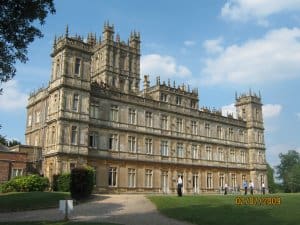
Highclere: they don’t build them like they used too
By Hamish Johnston
If you ask a British physicist to name a successful university spin-out, chances are they will say Oxford Instruments.
The company was founded 50 years ago by Martin and Audrey Wood — and has become a “household name” in physics labs throughout the world.
Yesterday I was invited to a series of lectures in celebration of the firm’s golden anniversary at the magnificent (and I don’t use that word lightly) Highclere Castle near Newbury.
Highclere is home to the Earl of Carnarvon, whose great-grandfather — along with Howard Carter — discovered the tomb of Tutankhamen. Under the house is a small museum dedicated to King Tut, and we were given a personal tour of the collection by the present Earl. Upstairs in the grand rooms one can also admire several family portraits by Joshua Reynolds.
But enough about Highclere…I was there to learn how a firm founded around a kitchen table in 1959 — and used a garden shed as its first manufacturing facility — has grown to employ over 1500 people in 25 offices worldwide.

Sir Martin Wood
As its name suggests, the firm had its origins at Oxford University’s physics department, where Martin Wood’s day job involved designing and building lab equipment — including high-field magnets, which the Woods realized that they could make and sell.
According to Audrey Wood, who is also the firm’s historian, the early success of the company can be traced back to the 4th of November, 1961 and a decision made on a New York subway train. The Woods were in town for a physics conference and became convinced that they should wind magnets using superconducting wire.
Although superconducting magnets are more expensive than their copper counterparts, they can deliver extremely high magnetic fields without the need for large and very expensive power supplies.
At the time there were only about 10 facilities worldwide that had the need for — and could afford running — Oxford’s high-field magnets. By switching to superconducting magnets, the Woods figured this would rise to 10,000 potential users.
They were right…and soon the magnets were so popular that the users were struggling to buy enough liquid helium to cool them. This led to another crucial decision by the Woods — to buy a helium liquefier in order to supply its customers. This signalled the beginning of a cryogenics business group that became famous for its commercial dilution refrigerators — which can cool samples to below 2 mK.
But the biggest boost to the company’s fortunes came in the 1980s with the development of magnetic resonance imaging (MRI) systems for medical use. In order to keep pace with the demand for MRI magnets, the company was floated on the London stock exchange in 1983.
Martin Wood was knighted in 1986 for his services to science. At Highclere he described how being treated shabbily at his first job — making farm machinery at the the age of 15 — left him wanting to start a company that would thrive by treating its employees with respect. He certainly seems to have done that.



